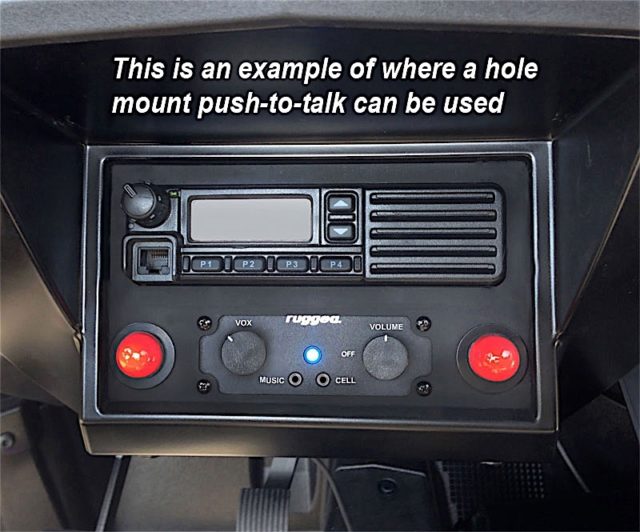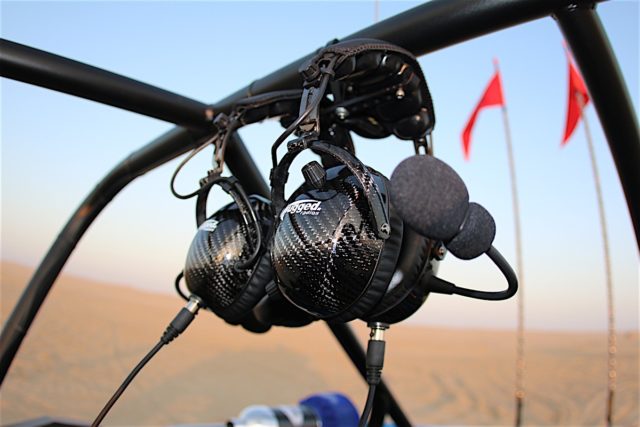One saying that is never good to experience on your own is, “you do not know what you need until you need it.” This is especially true when being on the trail or the middle of the desert.
Communication, whether in a group or alone, can be a life saver. We reached out to Mike Ruzicka of Rugged Radios [2] to get the inside scoop and education in off-road communications 101.
Radio
Two-way radios have been around for a long time. Most refer to a two-way radio as a walkie-talkie, but those are very different from the radios used today. UHF or VHF frequency radios come in a variety of styles, sizes, and power range.
Your average handheld radio will have around five watts of power, allowing you to transmit up to two to three miles away. Handheld radios are extremely popular, since they are small in size and portable.
The radio can be a lifeline out in a case of an emergency while off-roading.
Mobile radios are usually hard-mounted in vehicles and run off of a 12-volt power source. These radios start at 25 watts of power and go up to 110 watts, but most are usually 50 watts. They will get around 25-30 miles of range. Some radios are dual-band UHF/VHF and some are waterproof/dustproof.
Intercom
An intercom system is a central source for communication in a loud off-road vehicle. The intercom is often confused for a radio, the intercom is a small box with knobs and switches on the front panel.
Each person in the vehicle will be wearing either a headset or a helmet wired for communications. Each of these passengers will be connected directly to the intercom, allowing everyone to talk to each other. Now you can have the same great conversations you normally would, all while flying through the desert with no windshield.
The intercom is a valuable tool that lets all the occupants of the vehicle talk to each other, regardless of how loud it is.
The intercom is voice activated and full duplex which allows everyone to talk at once. All passengers in the vehicles can speak to one another without pressing buttons.
Most available intercoms allow electronic devices to be connected with a 3.5mm cable or through a Bluetooth connection. For example, Rugged Radios [2]‘ RRP660Plus Bluetooth intercom can play music or make phone calls.
Intercoms also allow for connection to an action sports camera, so you can record all of the conversations you have while off-roading. Want more? Up to eight people can be connected to the same intercom. Some of the most common applications for intercom systems are: Fire trucks, aviation, air boats, desert racing, and rally racing.
Antenna
The antenna is extremely important to the radios performance. The overall length is determined by the frequency you will be using. Most antennas are no ground plane antennas, which means they do not need to be mounted on a metal surface.
This is great for UTVs or race vehicles with either plastic or fiberglass roofs. Another important feature that goes with the radio antenna is the coax cable, which runs from the radio to the antenna.
There are multiple ways to mount an antenna to a vehicle.
The cable is 17 feet in length, which is usually too long, but it is very common for people to roll up the extra coax cable and zip tie somewhere out of the way. Doing this will cause major issues and dramatically affect the potential range this radio has. Therefore, the coax cable should be trimmed to fit, or routed in such a manner that it is not coiled up.
PTT – Push to Talk Button
This is a button connected to the intercom that allows you to transmit out of the two-way radio. PTT buttons that can be flush mounted to a dash, steering wheel, or Velcro-wrapped onto a grab handle.
Headsets
There are two styles of headsets: behind the head (BTH) or over the head (OTH). Functionality is pretty much the same, but the way it sits on your head may be the deciding factor on which one you would want.
BTH headsets are common for fast-moving off-road vehicles. It has an adjustable Velcro strap above the head, as well as a metal band behind the head. The metal band makes it more difficult for the headset to fall off of your head while going through rough terrain.
There are two different headsets used off-road: behind the head (left) or over the head (right).
The more traditional OTH design headset only has one metal band, along with a pad that goes above the head. There are a variety of headset styles, colors, and different types of mic booms.
Most headsets will typically have a volume knob, intercom/radio port, and a 3.5mm port for a music cable or race receiver.
Single Channel Receiver
Single Channel Receivers are mandatory for a lot of circle track racing sanctioning bodies. TORC, LOORRS, IMSA, and USAC are a few examples that require a single channel receiver.
The person using the single channel receiver can vary between driver and spotter. TORC requires the spotters to have the receiver, while others require the drivers to have the receiver.
Crew Chief Setup
A “Crew Chief” setup is a handheld radio connecting to a headset. This is a great way for anyone on foot to talk to another person in a high-noise environment. All types of racing can use this setup, but it can also be used for things like tractor operator, airboat, heavy machinery/factory, etc.
Installation
Now that we understand what each component is, comes the most important part – the installation. The installation of the radio can take the best radios and make them underperform.
“Last but most importantly, the coax cable going from the radio to the antenna should not be coiled up,” Ruzicka continued. “If you coil up the extra coax cable, it will drastically affect the radio range and performance. If the coax cable cannot be trimmed to fit, it should be routed around the vehicle as much as possible.”
Installing a radio and intercom system is much easier than you think. The back of the intercom is clearly labeled with easy “plug-in” cables. With a “power-y cable,” you can link power from both the intercom and radio into one power cable that goes directly to the battery.
Getting everything up and running is just a matter of mounting the radio, intercom, and antenna in good locations. Installation for a complete system can be done in under two hours.
Communications In Racing
Whether you are a weekend warrior or professional racer, communication is important. Communication is for more than just talking to your buddy on the trail; it plays a vital role in the safety of drivers.
“Communication in all racing series is similar and equally important when it comes to safety,” Ruzicka explained. “At race events, it is crucial for race operations and safety crew to have radio communication with each other. At most short course races, the safety crew will already be notified about a wreck before the car comes to a complete stop. Seconds can make a huge difference in saving someone’s life.”
Whether it is in the desert or during an Ultra4 race, drivers and teams rely heavily on constant communication.
The type of radios and communication vary in different types of racing. “There are a variety of different styles of racing that use two-way radios,” Ruzicka said. “NASCAR, for instance, relies on two-way radios for strategic pit stops for fuel and tires. Short-course off-road racing uses spotters to talk to the drivers and let them know where the other drivers are on the course, or if there is a better race line.”
“Long-distance desert racing uses two-way radios to get in contact with pit crews ahead of time to ask for spare parts, tires, fuel, waters or food,” Ruzicka continued. “High-powered radios are also very popular for long-distance racing, where smaller radios will work just fine at a three-mile, short-course track. In short, communications at all race events make them smoother and safer for everyone to enjoy.”
On Your Own
We won’t be having a test at the end of this article, but our test will come when it comes time to use our radio. “Don’t be scared to use these radios,” Ruzicka said. “They are awesome and can make your adventures a lot more fun.”
“You can start off small with a five-watt handheld radio and upgrade later on to a 60-watt radio,” Ruzicka finished. “If you get a chance to go to an off-road race, ask the drivers about the radios they use and how important they can be.”
Wherever your adventure takes you, make sure that you stay safe and well-informed. For more information on Rugged Radios and its products, be sure to check out its website [2] or YouTube Channel [25].






















